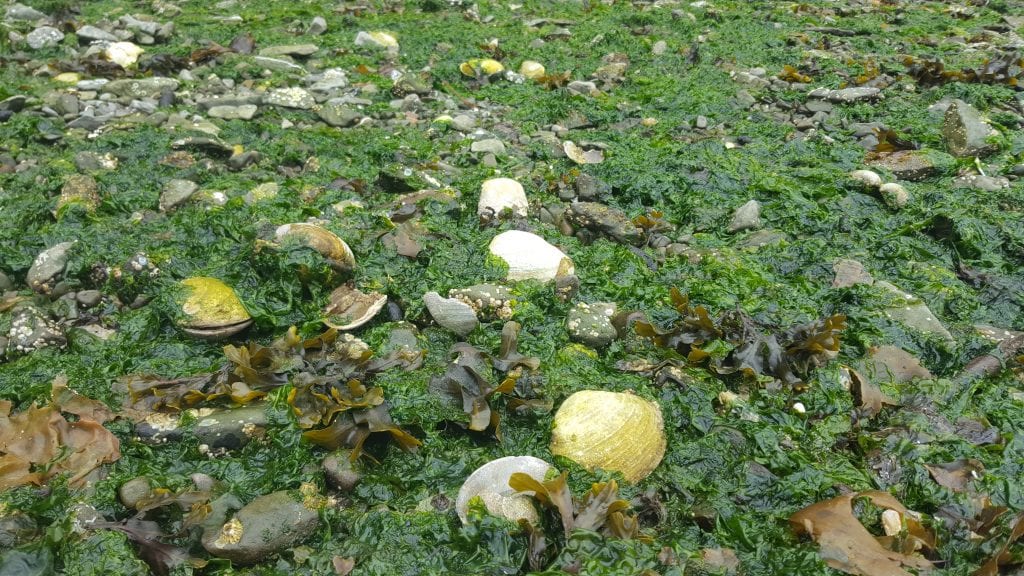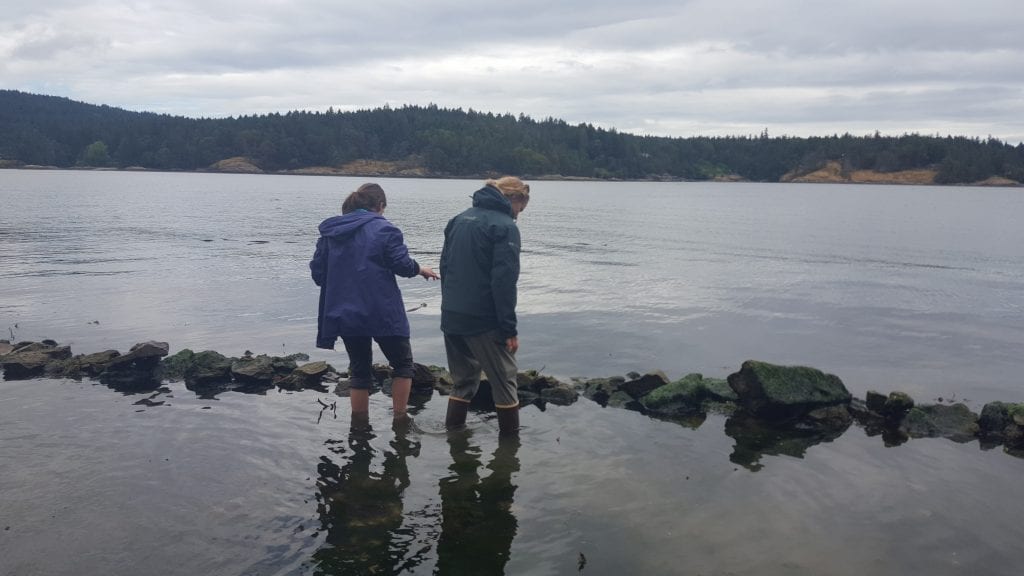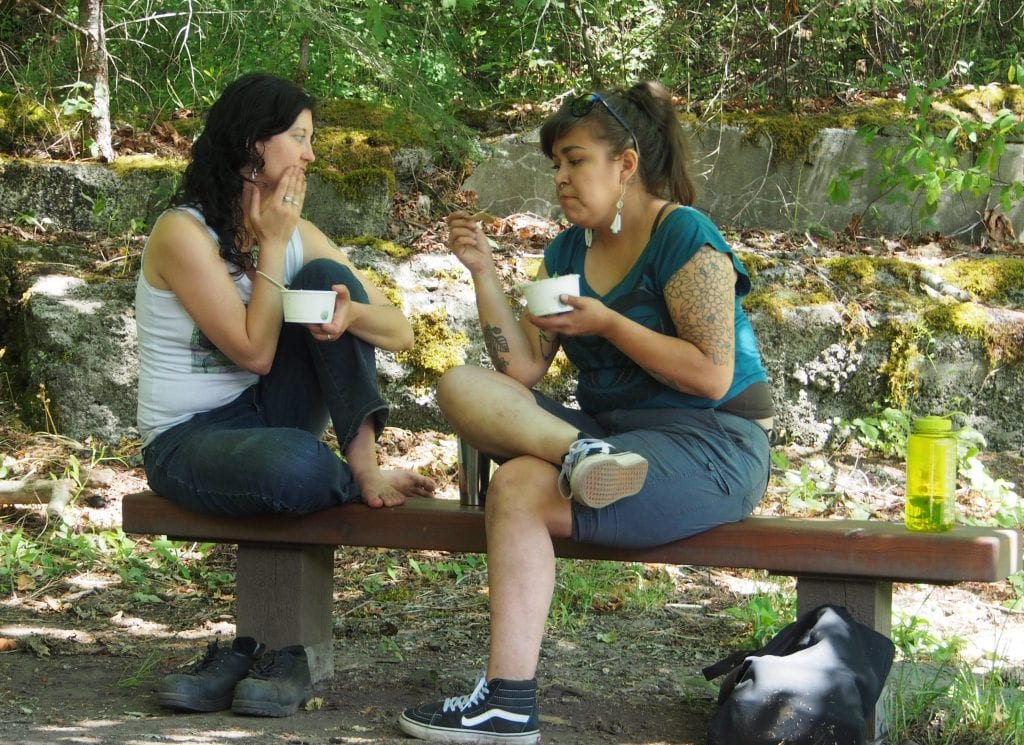By: Amanda Patt

Welcome to the blog for the Redfish School of Change 2018! This year Redfish is traveling with 16 students, 5 instructors around the lands and waters of the the heart of the Salish Sea. Traveling everywhere with us will also be Rudy Redfish, our many-storied, plastic fish mascot of great importance (pictured above).
The itinerary for Redfish features seven learning locations on both sides of the Canada/USA border: beginning online, Galiano Island, Salt Spring Island, the Saanich Peninsula, Anacortes and Padilla Bay, Orcas Island, and Sucia Island. Redfish is an ambitious blend of the academic work combined with diverse land-based education, work and volunteering experiences.
Greetings,
I’m Amanda. I would like to share with you some of my experience so far from the second week of Redfish 2018.
Pre-Redfish
It feels a little unreal being here in person after having prepared for this program for months. I applied for this program back in February, organized the funding for this trip in April, found housing for part of the summer, started learning how to ride a bike in May, borrowed and bought camping gear in June and completed my pre-readings in late June.
Even before the program started, I had so many hopes and fears, so much uncertainty about what Redfish would be like. I had a bit of nervousness about how physically intensive this program was going to be in terms of human-powered transportation (biking, kayaking, hiking etc.). I also was experiencing excitement and gratitude for the opportunity be able to participate in such an immersive, transformative, ecologically-progressive, community-oriented field program.
Online -Week One
Then we started the introductory online portion of Redfish. Our discussions ranged from practical logistical concerns such as gear lists, and travel arrangements, to whimsical-yet-critical thinking inspired by our readings on how to be brave, how to organize change, how to lead, how our social positionality affects our stories, how to create community, and much more. These readings gave rich material for us to problematize the stories told in a capitalistic, consumeristic, Westernized, stratified, nation-state worldview, and for how to re-story ourselves and our communities in hopeful, ecologically-sound, inclusive, sustainable, just, renewing ways.
Our daily assignments and discussion posts challenged us to go out of our comfort zones and problem solve in the moment. For instance, we conducted a recorded interview with a leader in our lives, with the technology we had with us at that moment, within the next 4 hours if possible. It was a challenge to find a someone in my life who is a leader, who also happened to be free on a weekday mid-summer, as most people I had thought to ask were either working or vacationing at that moment.
Galiano Island -Week Two




Our home here on Galiano Island has been the Millard Learning Centre, which is owned and operated by the Galiano Conservancy Association. This site has been a blessing for Redfish students and instructors alike, as it provides a perfect base to begin our in-person, within-the-landscape journey together.
This site contains 188 acres of diverse ecosystems which interconnect with other conserved or restored habitats on Galiano Island. The site also features a beautiful solar-powered Learning Centre building, old farm cabins, innovative composting facilities including a composting toilet, a food forest, native plant restoration sites, bat and bird boxes, rockfish exclusion zone monitoring, and so much more. My favorite thing about this Centre has been the organisms I’ve met here, from ochre stars, to old growth trees (Dougla fir, arbutus, cedar), from decorator crabs, to an osprey, from moon jellies to otters. My favorite new abiotic landscape feature I learned about is known as tafoni, a circular pitting of sandstone rock caused by erosion due to salt crystals that have evaporated out of ocean water.


A small snapshot of the many things I’ve experienced in Redfish include: we have had deeply personal sharing circles, learned how to take rotations for planning and cooking meals, done on-site trail building, had introductions to all of our courses, talked about site safety and logistics, rowed the oars of replica Spanish wooden ships (thanks Eric!), learned about community maps and created some ourselves (thanks Ken!). As well, we have: made and drunk grand fir and Douglas fir tea (thanks Reed!), learned about the dangers of nettles, foxglove and thistle, explored our readings on First Nations Rights and Title, colonization, the power of being able to name things or places, have explored the intertidal zones to talk about the beings that live there and discussed the importance of empowerment, equal and ongoing relationships with the local First Nations.


Of course, Redfish is an academic program, worth three University-level course credits. So, we have also had time to be introduced to the assignments that will be expected of us. This has felt a little overwhelming in the face of so very much occurring, and so very many things planned in a day. Many of us have been feeling some anxiety about when we would have time to read readings we had not yet gotten to, work on assignments, create group work, and connect with the technology that we have been mostly taking a break from. These assignments range from setting personalized learning goals for ourselves, to community mapping, to creating a blog post, to deepening our understanding of vocabulary terms, to thinking about what need we may be able to serve through our community action plan after Redfish.
In addition to all the other things happening, there was also time built into our tight schedule for “personal ecology”. This is meant to be time to do holistic self-care, whether that means taking a walk down to the beach, or a run in the forest, or create art under a tree, or writing a song on the bluffs; this is a time for each person to ground their body, mind, and spirit in the land.
On Friday morning, we will forgo oatmeal porridge and stewed fruit in favor of a quick breakfast, so that we may clean and pack up our presence from this site and travel to our next destination. We have been told that this too is part of the process, that traveling this landscape and this waterscape will allow our Redfish journey to be exactly what it should be. So, we’ll pack up our tents, and bicycles, and food store boxes, and Rudy and all of us, and we shall continue our journey on Salt Spring Island.
Thank you to Keith, Laurel, Haley, Heidi, Emily, Reid, and Ziggy for allowing the 2018 Redfish cohort to stay at Millard as we build this community, as we allow it to emerge into being.
Land Acknowledgement

So, this is a place of discomfort for me. Much of our curriculum has revolved around the continuing colonization and genocide that those in a socially privileged position as a Settler people perpetrate upon the on Stolen, Unceded territory of Indigenous peoples, whose territory it has been since time-immemorial. This colonization extends to more-than-human species and whole ecosystems as well.
Though we heard numerous personal territory acknowledgements spoken, though I heard the names of the First Nations whose traditional territory I am in right now on Galiano Island, though we practiced reading aloud the names of these tribes, I remember none of these words as I write this now. It was necessary for me to lookup again that it is the Penelakut that is the First Nation group that the Galiano Conservancy Association works most closely with. Certainly though, there are other peoples who also have deep connection with these lands and these seas.
First Nations, here in the Salish Sea, and many places around the world, have been successful at living in their landscapes. Settler peoples often have changed landscapes drastically to live in them, and these changes have been damaging.
This is what I am learning in Redfish. It is the start of a transformation of learning how to live in communities that challenge a cultural norm of being separated spiritually from knowing a land deeply. Hence, within the bounds possible, Redfish seeks to deepen our knowing of the land.
It is but a drop in the ocean, even within the Seas of our own lives, but perhaps, if we learn one thing at a time, it can be the power of writing a new story for the Salish Sea, or the “Whulj” in Coast Salish: “the saltwater we know.” (Murphayo and Black, 2015).






